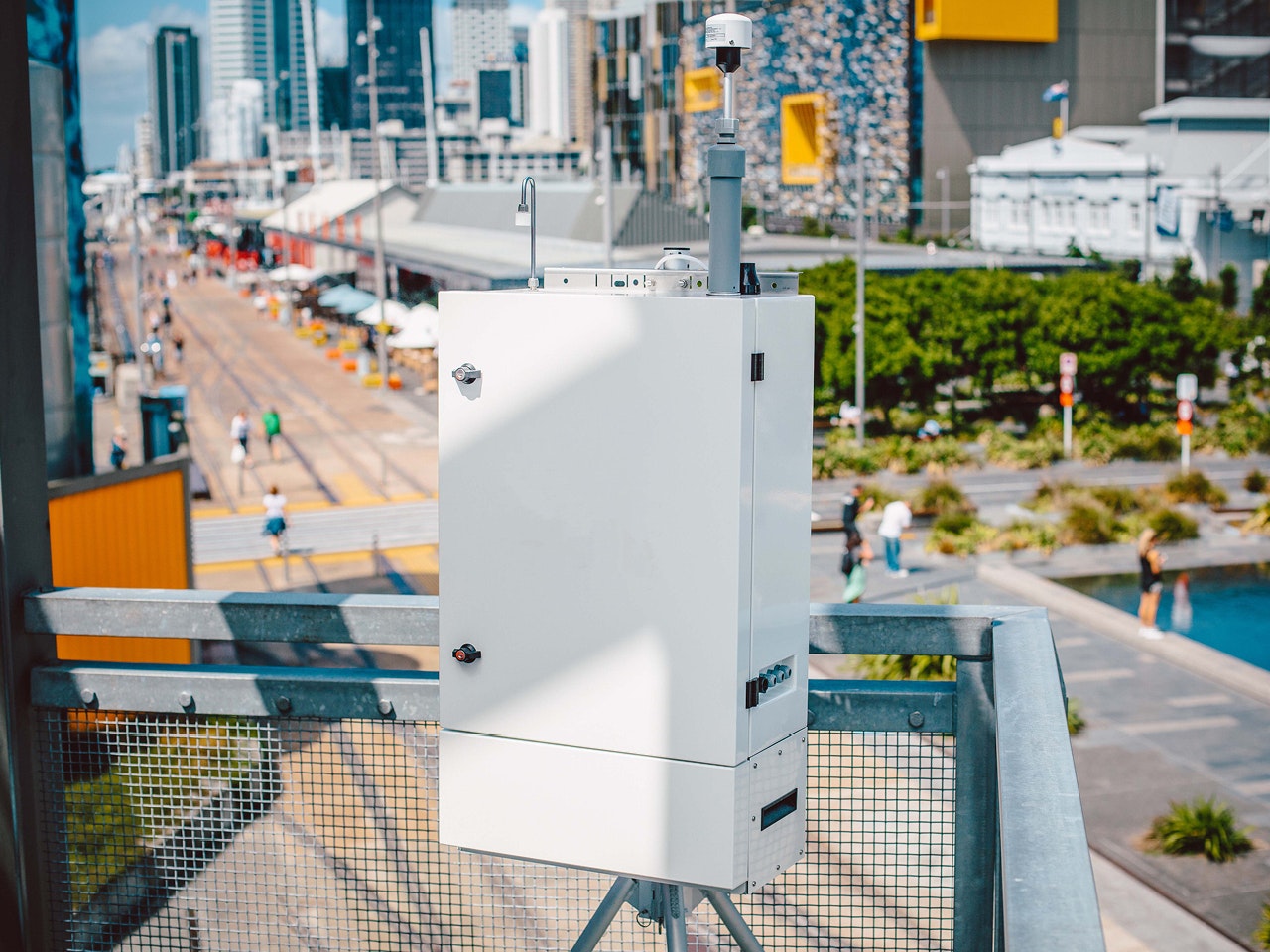Measurements
Volatile Organic Compounds
Aeroqual designs and delivers monitors that measure VOCs. Choose from our perimeter or handheld air monitoring range.
Here we cover VOC measurement principles, specifications and performance.
Overview of VOCs
Volatile Organic Compounds (VOCs) is the name given to a group of organic compounds which can exist as a gas in the atmosphere. VOCs are not listed among the six criteria health pollutants cited by the US EPA. However, the effects of VOC exposure are becoming more understood and demands for ambient VOC monitoring are increasing.
Perimeter air quality monitors
The VOC analyzer modules feature in our perimeter air quality monitors: AQS 1 Air Quality Monitor and AQM 65 Monitoring Station.
Two measurement options:
VOC module measurement principle
The sensor used in the VOC module is a photoionization detector (PID) sensor. The sensor generates an electrical current proportional to the concentration of gas that comes into contact with the sensor. The current generated differs depending on the organic compound, so the PID module is only quantitative towards the compound it is calibrated with; in most applications, this is isobutylene.
The VOC module is sensitive to a wide range of VOCs, including benzene and toluene, though not methane, ethane, propane, formaldehyde, or low molecular weight alcohols.
The patented VOC module design cycles between reading the sample air and reading air that has been filtered using a proprietary scrubber. This negates the effect of ambient air humidity changes, known to reduce the performance of a PID-based VOC measurement. The module has a controlled flow rate. The flow rate is determined by a flow control orifice on the exhaust side of the sensor and measured at the inlet to the sensor module (expected to be approx. 60 mL min-1).
The sensor current is converted to a voltage, and the voltage is measured and used to calculate the VOC concentration using a proprietary algorithm approximately once per minute.
VOC module specifications and performance
The VOC module performance specifications are given in the table below.
VOC Low Range
VOC High Range
Range
0-500 ppb
0-30 ppm
Display Resolution
0.1 ppb
0.01 ppm
Noise: Zero; Span (% of reading)
<1 ppb; 1%
<0.1 ppm; 1%
Limit of Detection
<1 ppb
<0.1 ppm
Precision
2% of reading or 1 ppb
2% of reading or 0.05 ppm
Linearity (% of FS)
1%
2%
24 hr Drift: Zero; Span (% of FS)
1 ppb; 1%
0.1 ppm; 1%
VOC module calibration and traceability
Just like a regulatory VOC analyzer using gas chromatography, the VOC module can be field calibrated using standard calibration equipment and reference gases. This ensures the module calibration is fully traceable to NIST primary standards.
The VOC module factory calibration is achieved using a zero-air source, a certified calibration gas standard and a certified gas dilution calibrator. Isobutylene is the recommended calibration gas to be used for the AQM 65 VOC module. The Aeroqual AirCal 1000 or 8000 systems can be used to calibrate the VOC module in the field.
Calibration frequency will be dependent on the user’s data quality objectives and Quality Assurance Project Plan (QAPP), but based on the low rate of field drift the recommended calibration frequency is 1-3 months.
To demonstrate, multi-point gas test at known concentrations was carried out using the equipment described above. The gas test is split into low range and high range. The module shows good linearity (R2 = 0.99) over the entire concentration range studied.
VOC module high range time series plot
VOC module high range scatter plot of data with linear regression and coefficient of determination
VOC module low range time series plot
VOC module low range scatter plot of data with linear regression and coefficient of determination
Interferences
The VOC module response to other ambient air pollutants is documented in the table below.
Pollutant
Test Concentration (ppm)
Typical Module Response (ppm)
Isobutylene
1.0
1.0
Benzene
0.1
0.2
CO
1.0
No response
NO2
0.1
No response
O3
0.1
No response
SO2
0.1
No response
Ethylene
0.5
No response
H2S
0.1
0.025
PID sensors respond to a wide range of VOCs but are calibrated against isobutylene. Response factors for other target gases are used to convert the isobutylene equivalent reading to that of the target gas. PID response factors for a wide range of target gases are well documented and available via Aeroqual.
VOC module expected lifetime
The non-catalytic chemical scrubber has an expected life of 2 to 3 years.
The internal solenoid has an expected life of 2 to 3 years. The VOC sensor contains a lamp which has a limited lifetime. The expected lifetime of the lamp is approximately 200 days of continuous operation. The VOC module can be sent back to Aeroqual for a lamp replacement or replaced by a qualified technician using a lamp replacement kit, available for purchase from Aeroqual.
Handheld air monitors and fixed indoor monitors with VOC sensors
The VOC sensor heads feature in our handheld air quality monitors: Ranger, Series 500, and fixed indoor Series 900 air monitors.
Five measurement options:
VOC sensor head measurement principle
Aeroqual offers three different types of VOC sensor technology for measurement, including a sensor head for non-methane hydrocarbons (NMHC).
Technology
Sensor Type
Target Gas
VOC PID
Photoionization detection 10.6 eV
VOC
VOC GSS
Gas sensitive semiconductor
VOC
NMHC GSS
Gas sensitive semiconductor
NMHC
These sensors respond to a broad range of VOCs, although they each display a unique sensitivity to certain VOCs or classes of hydrocarbons. None of the sensor heads respond to methane.
The VOC PID sensor heads contain a photoionization detector (PID). This sensor generates an electrical current proportional to the concentration of gas that comes into contact with the sensor. The VOC PID sensor head is sensitive to a wide range of VOCs, including benzene and toluene, but not methane, ethane, propane, formaldehyde, or low molecular weight alcohols.
The VOC GSS and NMHC GSS sensor heads contain a gas sensitive semiconductor (GSS) sensor. These sensors are manufactured by Aeroqual. The sensing material for both sensor heads is a p-type semiconductor, whose resistance increases when the sensing layer is exposed to VOCs. The sensor resistance is used to calculate concentration using a proprietary algorithm.
VOC sensor head sensitivity diagram
VOC GSS sensor head specifications
The table below contains the VOC GSS sensor head specifications. The NMHC 0-25 ppm sensor head is designed for outdoor environmental monitoring. The VM 0-25 ppm sensor is designed for both outdoor environmental monitoring and indoor air quality. The VP 0-500 ppm sensor head is designed for industrial health and safety air monitoring.
Sensor code
VM
VP
NMHC
Sensor type
GSS
GSS
GSS
Range (ppm)
0-25
0-500
0-25
Detection limit (ppm)
0.1
1
0.1
Accuracy of factory calibration
<±0.1 ppm + 10%
<±5 ppm + 10%
<±0.1 ppm + 10%
Display resolution (ppm)
0.1
1
0.1
Response time (seconds)
60
30
60
PID Sensor head specifications
The table below contains the VOC PID sensor specifications. The VOC 0-30 ppm sensor head is designed for both outdoor environmental monitoring and indoor air quality. The VOCH 0-2000 ppm sensor head is designed for industrial health and safety air monitoring.
Sensor code
VOC
VOCH
Sensor type
PID
PID
Range
0-30 ppm
0-2000 ppm
Detection limit
0.01 ppm
0.1 ppm
Accuracy of factory calibration
<±0.02 ppm + 10%
<±0.2 ppm + 10%
Resolution
0.01 ppm
<1000 ppm; 0.1
>1000 ppm; 1
Response time
30 seconds
30 seconds
VOC sensor head calibration
All the VOC sensor heads are calibrated at the Aeroqual factory using isobutylene. However, for both VOC sensor types, the response differs depending on the organic compound. Response factors for other target gases can be used to convert the isobutylene equivalent reading to that of the target gas. Response factors for a variety of target gases are available via Aeroqual. If the atmosphere being measured contains a mixture of hydrocarbons (this is likely when measuring outdoor ambient air), the measurement is quantitative only.
Products that have VOC sensors
The following products measure VOCs, as well as particulate matter and gaseous pollutants in real-time.
Inquire about our VOC products
Our VOC advanced monitoring systems deliver hyper-local data and real-time alerts, giving you actionable data to make the decisions that matter.












